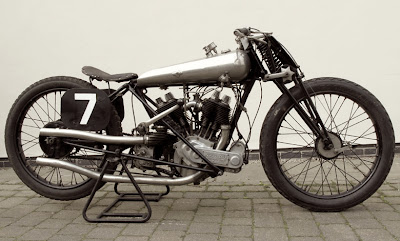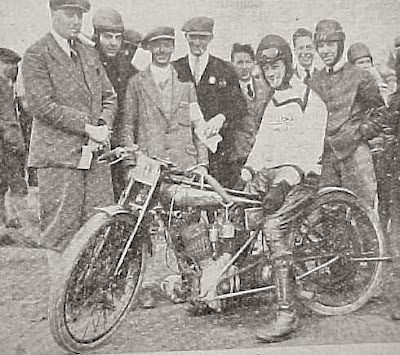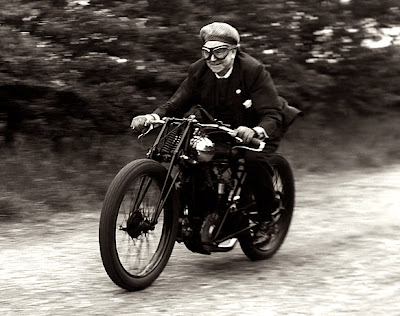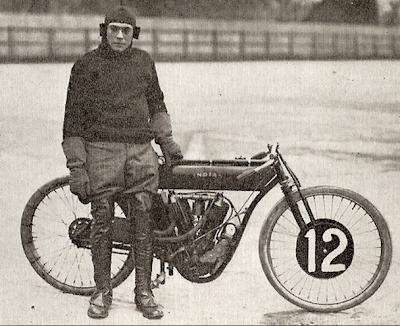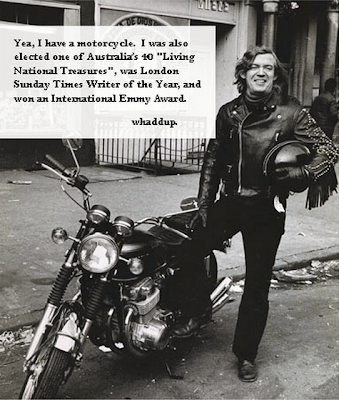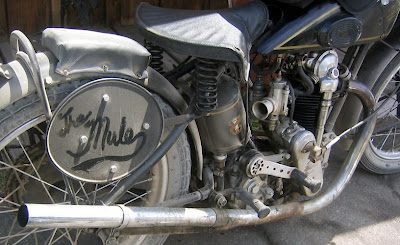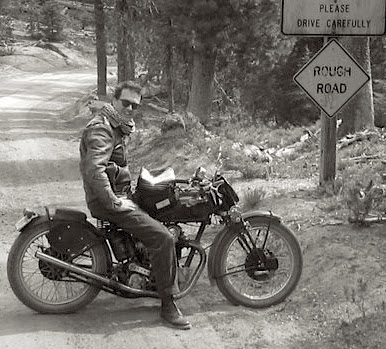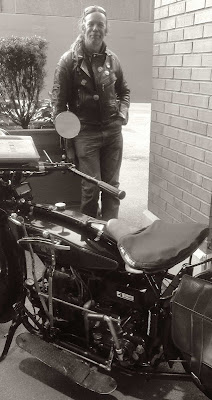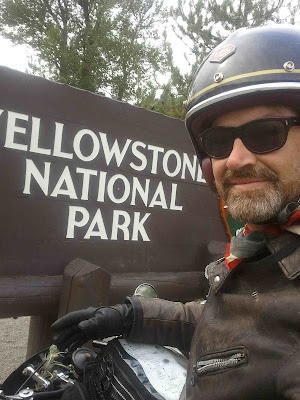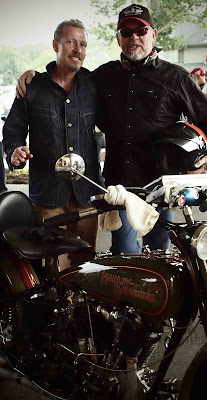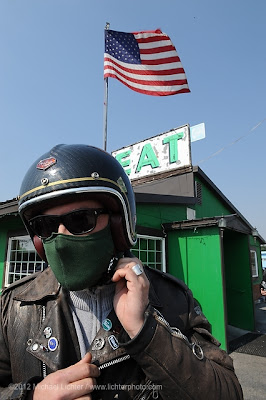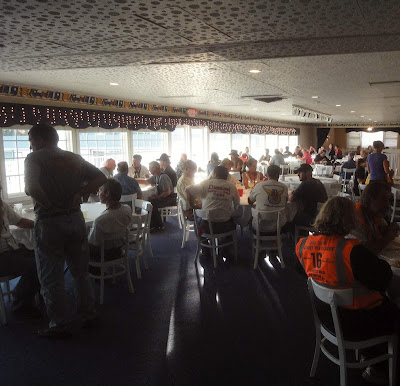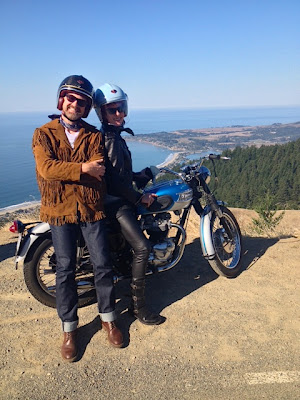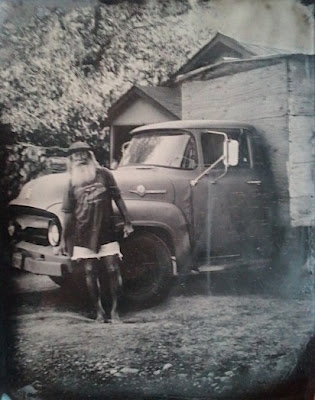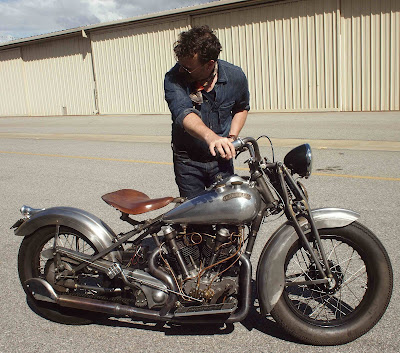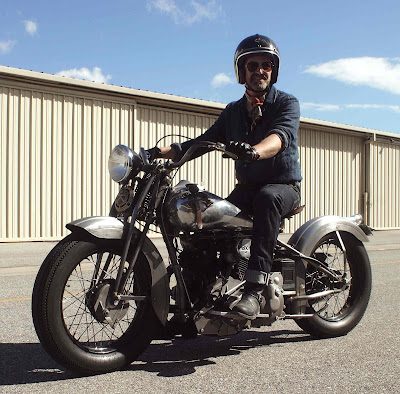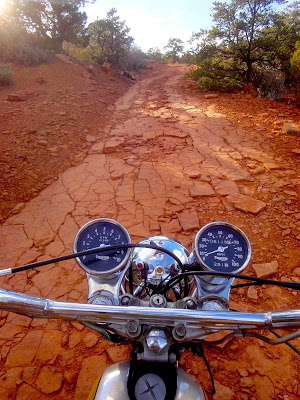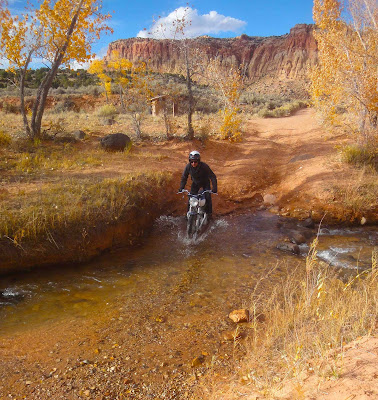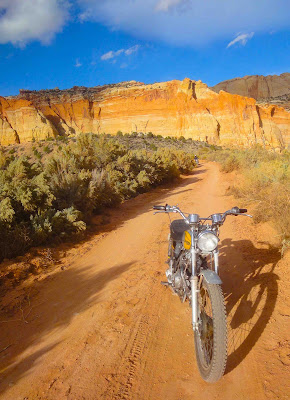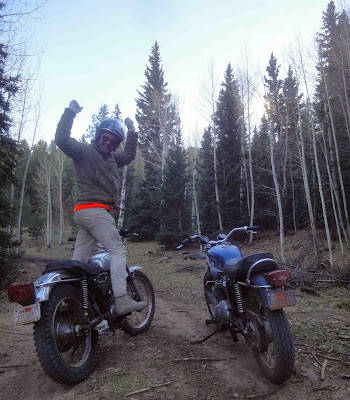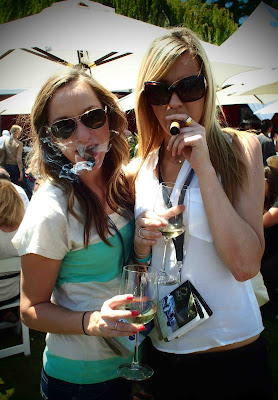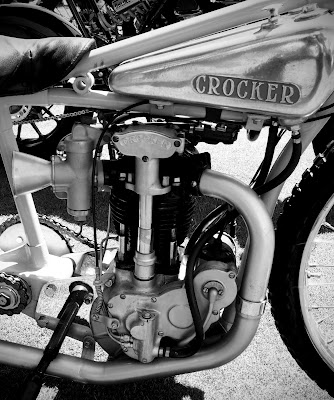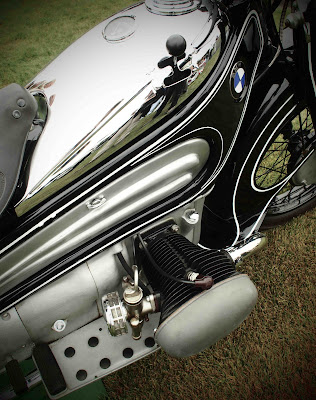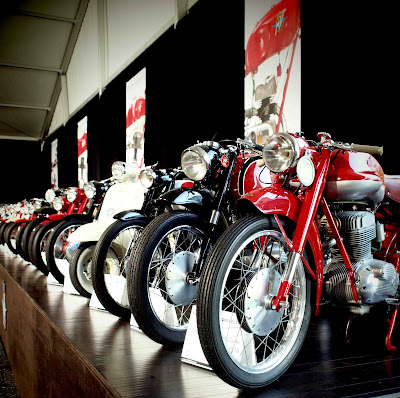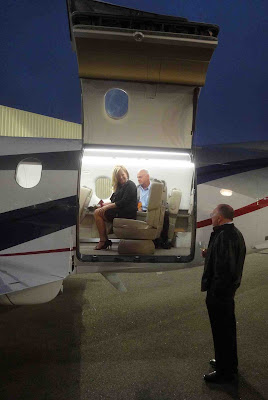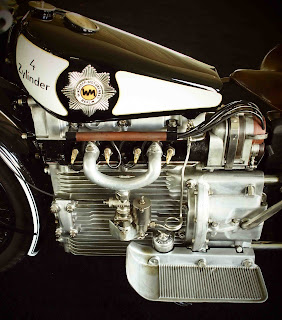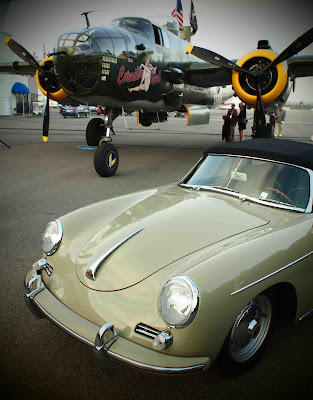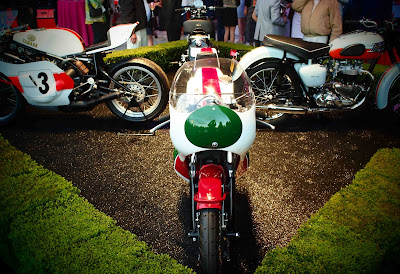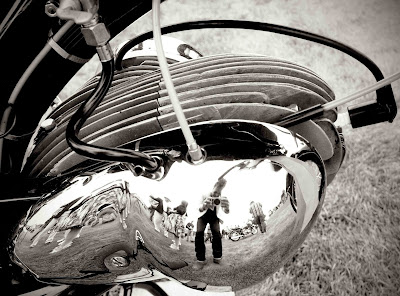I've posted the 'wet plate' photos in
Oily Rag, written
online articles for Cycle World, and will shortly have print stories in
MCN and
Café Racers (France)... even the roving Vintagent has to make a living...but patient readers of
The Vintagent get a different spin on the Motorcycle Cannonball Endurance Rally, an event I entered on a whim last January, well after the cutoff entry date, at the urging of a stranger, over dinner in Las Vegas, during the big motorcycle auction week. Perhaps the odd circumstance of my Cannonball's genesis was a warning, as some riders spent fully two years preparing their machines for the ultimate Vintage bike test, as the last Cannonball was back in 2010. After only a month's preparation, my ride was a brief and glorious 4 days through the Rockies -the most scenic roads, actually (
read about it here on Cycle World online).
I covered that first 2010 Cannonball from afar, not having a pre-1916 motorcycle; reliable friends who rode it were unanimous in their tales of difficulty and frequent misery, and the event's demands. Daily rides of nearly 300 miles on Century-old machines sounded insane, and the Cannonball's premise, a reprise of 'Cannonball' Baker's cross-country forays back in the 'Teens, seemed ludicrous. Baker's bikes were new when he rode them, when no roads traversed the US, whereas in 2010, the bikes were 100 years old, but the roads billiard-smooth(ish).
![]() |
| The magnificent Grand Tetons, shot in a lucky, and very happy moment, by Michael Lichter |
One hundred years later, Baker's challenge was inverted. Rumors soon circulated of 1915 Harleys gutted for new-and-improved internals; this would be a farcical competition between basically new vs. genuinely old motorcycles. And so it proved, as stalwart antiquers like Pete Young (1913 Premier) and Shinya Kimura (1915 Indian) spent night after night battling mechanical demons in ugly parking lots, while a cabal of new bike riders adjusted chains for 10 minutes, then retired to the bar for an hour of joviality before retiring to an early bed. To be sure, there's a place for every kind of motorcycling in
The Vintagent's world, but the Cannonball wasn't a level playing field; two very different events ran concurrently - an outrageously difficult old bike tour, and a cross-country jaunt on new machines which looked old.
![]() |
| Geo Roeder tranforming a Panhead valve into a Velocette item... |
What shone in the 2010 Cannonball were the riders of Real old machines who finished with perfect (or very high) scores, meaning, they'd conquered the damn thing! Foremost among them, Brad Wilmarth (1913 Excelsior) and Katrina Boehm (1911 JAP single), deserve a special place in the Old Bike world. This wasn't a test of a perfect restoration, which granted can involve years of determined parts scrounging and self-education, and it wasn't about rarity or fascinating provenance; none of that mattered in fact.
![]() |
| The very first mile in Newburgh, New York, en route to the Motorcyclepedia Museum |
What those riders of genuine machines achieved speaks to very heart of
The Vintagent, laid plain on the bottom of every page since the first day in October 2006,
"Ride them as the maker intended." And, having completed (sort of) my own Cannonball in 2012, the importance in this event to my motorcycling values overshadows the years spent as Concours judge and commentator and collector. While I defend and expand our historical understanding of motorcycles in culture (laid plain in my 'mission statement'), motorcycles as static relics are ultimately dead things; I'm a rider first, and I prefer old motorcycles.
![]() |
| Doug Wothke, who camped with his Indian Scout most of the Cannonball, standing by one of 14 Excelsior-Hendersons entered |
Every Old Motorcycle event is important to keeping the global vintage community healthy, but the riding events are the most important; a bike in motion is a live animal, gives its owner unique pleasure, and, because parts break or wear out, riding keeps vital spares in production. It also nourishes that ephemeral body of 'know how', the secrets and tricks which make maintenance easier, and good running possible.
![]() |
| Outside the Harley Davidson Museum in Milwaukee, with a posse of strangersT |
The Motorcycle Cannonball Endurance Rally is the most important vintage motorcycle event on the planet. Free of glamour, free of exclusivity, free even of decent food or coffee, the Cannonball has emerged as the ultimate statement of one's commitment to keeping old bikes alive - 3956 miles of riding the hell out of them. No other Vintage event comes close; the Cannonball is the 800 pound gorilla of the old bike world, and it has already piqued global interest, with 14 different countries represented this year (South Africa, Japan, England, Ireland, Germany, Italy, Brazil, France, Poland, Australia, New Zealand, Canada, Texas, and the USA).
![]() |
| An exhibit of ghosts in the HD Museum... |
In that vein, I have one suggestion for the next Cannonball, if there is one (always a question with old bike events run by individuals...
vide the
Legend of the Motorcycle show). Keep the dates and rules the same; ban non-riding mechanics. I think you know what I mean...
![]() |
| Riding over an 8500' pass into Yellowstone; a fantastic feeling |
And how much does the Cannonball really cost? Here's information you won't get anywhere else; an honest accounting of the expenses and sponsorship for a Cannonball run.
![]() |
| Making valves in the evening twilight... |
Team Vintagent is in the USA, so can only speak to domestic entries; I had 3 souls included; myself, van driver/Vintagent manager Debbie Macdonald (who drove to New York and back!), plus Susan McLaughlin, my photographic partner for the 'wet plate' images taken across the country. I spent ~$4500 completely rebuilding my ca.1930 Velocette KTT, which included parts (mostly from England) and some machine work, although
vintage stalwart Fred Mork built my crankshaft without charge, as a sponsor and friend. Thanks Fred!
![]() |
| Artist Jeff Decker and 'Fass' Mikey Vils |
Transporting the Velo from the Vintagent warehouse in San Francisco to New York required 5 days of Debbie's fuel and hotel/meal expenses in my Sprinter van, ~$1600. From Newburgh onwards, hotel, fuel, and meal expenses for the 17 days came to ~$3500; many meals were provided by sponsors/supporters of the Cannonball across the country, we only occasionally had to buy our own lunch or dinner, while breakfast, if you can call industrial pastries and crap coffee such, was usually gratis in our motel. Entry to the Cannonball was $1500. Fuel on the return trip across the US was ~$750, one-way plane tickets to NYC from SFO were ~$250 each.
![]() |
| Chris Knoop's Invincible-JAP lost its sidecar (and his wife!) early on...too much strain on the weak Albion gearbox |
During the ride, I required skilled hands and facilities to help make repairs, or modify parts. The first angel was Steve McPhillips of Mac's V-Twin in Newburgh, NY, who helped sort a seized valve on my very first day, and charged nothing. After another exhaust valve seized, Geo Roeder of
Roeder Racing and Service in Monroeville, Ohio made a new inlet and exhaust valve for me on specs given over the phone as we approached the state, barely making it before his closing time. Geo, a former flat-track racer and second generation champion, worked late on a Friday night to help me out, and didn't charge a penny. I repaired my cambox using facilities at J&P Cycles in Anamosa, Iowa, with the help of Joe Sparrow and his brothers, who have earned my eternal gratitude, working late in the spirit of goodwill, also without charge. Finishing my cambox machine work waited until Sturgis, South Dakota, where Lonnie Isam Sr opened the door of his
Competition Distributing facilities; we had free access to all his machinery and even lifts, as well as his super-dry and crusty humor. When I thanked him after rolling my Velo off the lift, he smiled and said, 'Get out.' Lonnie and his mechanics stayed late for two nights, and charged nobody anything. Amazing.
![]() |
| Debbie Macdonald, production manager at The Vintagent, and team driver |
Totalling up, my expenses were approx. $12,500, and I reckon few could have done it cheaper; I already had the Velo, a van, and volunteer helpers. One who did it for less was Doug Wothke, who rode his Indian 101 Scout from Alabama, and camped! Always an option for the hearty, although the temperature did drop to 25 degrees in
Yellowstone National Park.![]() |
| Nice to run into Fritz Simmerlein, of Harleysons MC Germany, at the HD Museum |
Who paid for it? Much was from
The Vintagent's pocket. The photographic expenses (and half our hotel bills, plus my entry fee) were paid by Susan McLaughlin, who saw the value in such a unique photographic opportunity to take the 'wet plate' shots - stay tuned for a print project using our images. I was sponsored $3000 by
'Oily Rag' publisher Douglas Blain, hoping to use the Cannonball to launch interest in the new magazine, of which I'm editor in chief. Please
'like' Oily Rag on Facebook here, and
read it online here - it's good stuff, and most of my 'wet plate' photos are posted there.
Bonhams, my principal sponsor for
The Vintagent website, gave $500. Jared Zaugg at
Bench and Loom asked the week before the ride if I needed good boots, and I did; he sent a beautiful pair of Tank Strap boots, which kept the oil off my socks, and didn't give me blisters!
Private White V.C. sent a gorgeous blue-with-copper trim waterproof jacket designed by
Nick Ashley, which you can see in the sidebar ad; I didn't need to wear it as my ride was rain-free, but you'll see it on me in the future.
Les Ateliers Ruby provided my carbon-fiber Pavillon helmet; at least my head was swathed in luxury while the rest of me was often freezing over the Rockies! Eternal gratitude to all my sponsors; I couldn't have done it without you.
![]() |
| Lichter captures the Pickle place... |
![]() |
| Another Lichter photo; there's a lot of this across America... |
![]() |
| The BMW invasion |
![]() |
| Claudio from Italy on his lovely Sunbeam Model 5 |
![]() |
| Bill Buckingham and Chrys Pereira check over the JD... |
![]() |
| Buck Carson on his 21st birthday. After the piston melted on his BSA sidevalver, Buck pushed his mount across the Golden Gate Bridge; 'no way is my bike going across the bridge in the van!' |
![]() |
| Angel #2 Geo Roeder as a cutout... |
![]() |
| The source of all my trouble... |
![]() |
| I spent my 50th birthday in this exotic locale in Iowa... |
![]() |
| Mike Wild on his Rudge |
![]() |
| After a night of wrenching, the Rum. Note 'Kum and Go' shorts....that's actually the name of a Gas station chain; amazing, had to have 'em. |
![]() |
| Sean Duggan with morning coffee... |
![]() |
| Team Vintagent/Oily Rag, stopped for milkshakes, somewhere in rural Pennsylvania |
![]() |
| Shinya and Ayu |
![]() |
| Shinya's 1915 Indian |
![]() |
| Lots of soybeans across America... |
![]() |
| Angel #1 Steve McPhillips |
![]() |
| Hilarious trailer of 'The Ochos'; Spanglish Cali nonsense... |
![]() |
| South Dakota vignette... |
![]() |
| Waiting for the morning's timed start; each class had a specific check-in time |
![]() |
| The remarkably reliable 1913 Excelsior... |
![]() |
| Brad Wilmarth, with his 1913 Excelsior, with which he's won both Cannonballs. Brad is the Cannonball King. |










